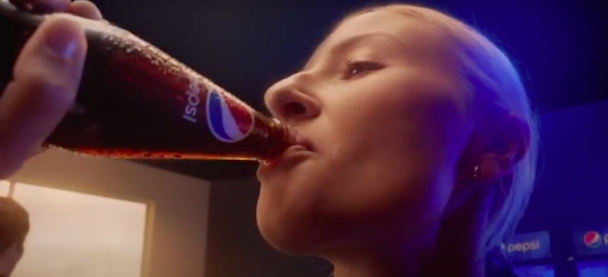Is the marketing industry doing enough to ally with LBGTQ+ workers and communities?
Marketing is often seen as a ‘safe’ industry for members of the LGBTQ+ community to work in. But is it doing all it can for both employees and consumers? The Drum Network hosted a panel to find out.

Pepsi’s partnership with Leah Williamson is an example of LGBTQ+ advertising done right, said one panelist / Pepsi via Youtube
June is Pride month and the time of year the world seems, especially, ablaze with rainbows. This is, of course, thanks in part to the work and effort of marketers. But does the rainbow point to a pot of gold? Or does the technicolor mask malaise among LGBTQ+ employees?
The Drum Network hosted a panel of industry experts to poll their opinions on how well the sector does for queer employees and in terms of LGBTQ+ output. We also asked how to reach the queer community meaningfully, respectfully, and effectively.
Want to go deeper? Ask The Drum
Diversity, Equity, and Inclusion?
So, what’s it like to be an LGBTQ+ person working in marketing? Tim Noblett, head of data at TMW and director of marketing for Pride in London, sums up the tension felt by some working in the sector between outward appearances and lived experience.
“We're an industry that believes it‘s quite left-leaning,” he explains. “It considers itself very open, and ‘I never had any issues,’ but I think people then don‘t make the effort to actually do the work to understand different opinions because it's just seen as very ‘welcoming’”.
Noblett adds: “I think other industries have done more groundwork in terms of training and understanding employee resource groups.”
To illustrate, Noblett points to the added stress he feels at having to come out time and time again to clients, and the anxiety that can bring. Ben Wheatley, business director at Found, explains that he’s had similar experiences with his pronouns. “I identify as he/they internally, and with clients, it is consistently like: “Oh, explain that to me then.” I‘m usually happy to, but it‘s exhausting. I imagine a few people have that.”
Wheatley says he uses Pride month to explain LGBTQ+ terminology to people in his network. “I‘ve taken it upon myself to just mass send emails out to say: ‘Here's what all the different letters mean, and here's what the different bits are within that’”. The industry, he feels, is still 20-30 years away from having ‘better visibility’.
Microaggressions experienced by LGBTQ+ staff members, recounted by some members of the panel, show there’s still work to be done. From queer couples unsure about rights to parental leave, to transition journeys not being understood or accommodated, to queer staff facing discriminatory conversations while both in and out of the closet, to having to fundraise for Pride events when agency funds weren’t forthcoming – most of our panelists, sadly, had a story to tell.
Ren Cavan, UK group creative director at Momentum Worldwide, points to conversations with younger colleagues as proof the industry isn’t the paragon of inclusion it might sometimes pretend to be. “There’s a real sense of: ‘Is it safe for me to identify as openly out and within these communities?’ And: ‘Should I be putting my name on the invite list and making myself really visible in that way that opens me up to being potentially in some ways unsafe?” they say.
Fight for your right
Is it any wonder the employment landscape is still fraught in a world defined by the ‘culture wars’, which in turn provide the backdrop for a lot of work made with queer talent?
“We didn‘t used to be a culture war,” Noblett says. “Brands could dine out on our community and join us, and there wasn‘t a backlash.” He points to the example of transgender contestant Nadia Almada winning Big Brother UK in 2007, which he doubts would happen today with the trans community “under attack” (although, of course, Almada‘s own experiences on that show were far from idyllic).
“We need support more than ever because we‘re back at the front of the battle, and we are part of the culture wars, and brands are scared to do that,” he says.
Panelists reflected that representation often lacks, too, in the talent agencies can provide for film and photo shoots and in client briefs, which still too often stipulate heterosexual personas. White, cisgendered men often dominate in the queer representation that does happen.
Helena Taylor, paid social lead at Space & Time, points to a recent campaign for jewelry brand Pandora as evidence that an ‘element of fear’ still surrounds the use of queer subjects in advertising.
“They used a lesbian couple in it, and they received such a backlash and a petition against it. It was called ‘sexual perversion’. There was basically a petition to have it removed. I think when you see things like that, the smaller brands that I tend to work on, they're not going to want to make a statement or do anything to support that‘s going to be seen as too ‘out there’.
Cavan notes the prevalence of ‘pre-emptive compliance’ in the industry and broader culture. Essentially, this amounts to a tendency to play it safe, and sometimes discriminate in the process, for fear of having to answer questions and explain decisions further down the line.
Lina Maassarani, senior influencer talent manager at HypeFactory, says she sees in her work how this approach is bad for business. “It‘s often unclear to me why brands are not trying to work more with LGBTQ+ influencers because they have a great audience with gen Z, and if they want to target gen Z, it‘s a great platform for them to use.”
Queering the pitch
After the Pride flags come down at the end of June, can marketers still excel at reaching queer communities? And are they bothering to try? Jake Sage, paid media manager at Stellar Search, says to speak effectively to LGBTQ+ audiences, businesses must ask themselves questions. “Number one, why do we want to reach an LGBT audience? And I don‘t think it can be purely for economic reasons or profit; I think you have to have some kind of ethical basis. Number two, what are we doing, as well as saying, because the audience is quite savvy. If it‘s purely tokenistic, it‘s going to be seen through relatively quickly.”
Companies changing their profile icons to rainbow icons, to this end, can be perceived as a ‘red flag of tokenism’ as readily as a show of corporate solidarity. Sage also recommends brands work to make their output accessible to everyone rather than creating specific output for specific communities. “That sort of division sometimes can cause other problems,” he explains.
A third way exists, says Hannah Anderson, managing partner of social at NewGen, for brands trying to navigate the terrain of queer representation. “I don‘t know how to coin it, but, like, ‘subtle representation’. Or, just using people within the community, not because they‘re in the community, but because of what they do and because of what they achieve. Because, in my opinion, regardless of if we‘re in the community, we‘re just people at the end of the day.”
A perfect example, Anderson says, is Pepsi Max having footballer Leah Williamson as an ambassador. Why? “She’s the England captain,” Anderson explains. Point made.
Content created with:

TMW Unlimited

Found.
We're Found, the Everysearch™ agency. A master of search performance across all digital marketing platforms.
Employing PPC, SEO, paid social, and creative...

HypeFactory
HypeFactory is an AI-powered influence marketing agency that delivers top results for its clients. We stay ahead of the curve with data analysis and trend forecasting,...

Momentum Worldwide
Momentum Worldwide has a proud history of creating industry-first experiences that authentically place brands in the cultural conversation. 1,000+ individuals across...

NewGen
NewGen is a social-first creative and creator agency that stands at the forefront of culture, creators and community. On a mission to challenge outdated advertising...

Space & Time
Space & Time is a growth marketing agency, enabling clients to secure optimal value from every part of the customer experience and their marketing investment....

Stellar Search
We're a strategic digital marketing agency specialising in Paid Search, SEO, Google Shopping, Amazon and Social. We are recognised by Google as a top-performing...
